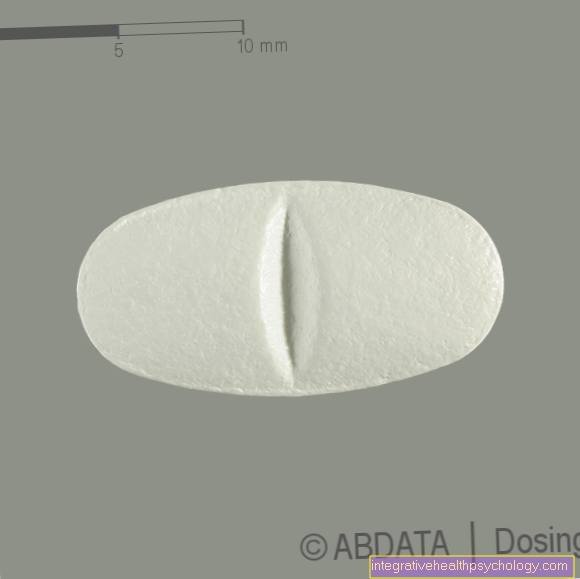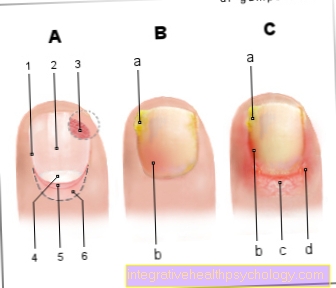Sun allergy in the child
definition
In children, exposure to sunlight can cause skin symptoms known as sun allergies. Various clinical pictures are summarized under the term. The word sun allergy is a slang term because there is no allergic reaction to sunlight in the medical sense.
The most common form of sun allergy in children manifests itself as redness, itching and blisters on areas of the skin that are exposed to sunlight. Most of the time, the symptoms appear in spring with increasing exposure to sunlight.

Typical symptoms of a sun allergy in children
A sun allergy in a child can be identified when typical phenomena occur in areas exposed to light after being in the sun or being exposed to sunlight, for example when driving a car. The individual appearance of each child can be different.
Typical symptoms are:
- Redness
- Nodules
- Vesicles
- severe itching
- Burn
The sun allergy is often noticed for the first time in a child because it often has to scratch the affected areas. If the skin symptoms are related to a stay in the sun, especially in spring, a sun allergy is very likely with the symptoms described.
However, if there are uncertainties or the child suffers from other symptoms such as fever, it may also be a different disease, so that a medical evaluation can be useful in such a case.
Where do these symptoms occur?
In the case of sun allergies in children, the symptoms and skin manifestations typically only occur on parts of the body that are directly exposed to sunlight. Depending on how the child is dressed, the face, neck, décolleté and hands are particularly affected. If these are not covered by clothing, the sun allergy can also appear on the arms and legs.
If the redness and blisters also affect areas of the skin that have been protected from sunlight, a condition other than sun allergy may be the cause.
How is the disease progressing?
The typical course of the disease in children with a sun allergy is that a few hours after the child has played outdoors in the sunshine, the typical itchy blisters appear on the skin areas that have been exposed to the sun. In this case, even a level of sunshine that is perceived as low at mild temperatures in spring can be sufficient to trigger the symptoms.
Protection from further sunlight and soothing measures against the itching usually heal the symptoms of sun allergy in children within a few days. In very rare cases, the course of the disease becomes more pronounced and the skin swells. In such severe cases, the child should be examined by a doctor for safety.
causes
Sun allergies are quite common in childhood and a distinction is made between various clinical pictures that are responsible for the symptoms.
The most common is the so-called polymorphic light dermatosis (PLD).
This is a congenital hypersensitivity of the skin to sunlight, although the exact cause has not been clarified. The symptoms typically appear in spring, when the skin is not yet used to sunlight. After the child has been in the sun, itchy nodules and spots appear in areas of the skin that have been exposed to sunlight. In the course of the year, the symptoms usually subside despite increasing exposure to the sun. This is because the skin gets used to sunlight. Over the winter, however, the habit is often lost again, so that the sun allergy symptoms can reappear in the child every spring.
However, polymorphic photodermatosis is more common in children than in adults, so that in many children the symptoms subside or go away as they get older. Girls are more likely to suffer from this form of sun allergy beyond childhood than boys.
Another less common cause of sun allergy in children is phytodermatitis or “meadow grass dermatitis”.
The interaction of plant substances that increase the skin's sensitivity to light causes sunburn-like reactions with sunlight. The skin changes therefore often occur when the child has had contact with corresponding plants such as hogweed perennials while playing outdoors. Occasionally, the skin reactions show typical patterns such as stripes due to grass that the child came into contact with.
A third cause of a sun allergy in children can be the use of certain medications.
Some active ingredients, like the herbal substances mentioned, make the skin more sensitive to light. As a result, sun exposure can cause the child to redden and itch. If skin changes occur while taking medication, it is advisable to consult the pediatrician.
How can you prevent sun allergies in children?
In order to prevent a child from developing a sun allergy, or at least to prevent it from appearing, they should be protected from direct sunlight as much as possible. For children under one year of age, exposure to the sun should be avoided completely, as the skin is still too thin and does not have sufficient pigments to protect itself from harmful influences.
Older children should wear adequate sun protection clothing and, if necessary, a sun hat and sun cream with a high sun protection factor. In addition, a sun allergy can be prevented to a certain extent by slowly getting the child used to sunlight in spring. For this purpose, many shorter stays outdoors should take place instead of longer periods in one go. During longer car journeys, the child can be protected by special sun protection films attached to the windows.
Read more on this topic at: This is how you can prevent a sun allergy
treatment
The treatment of a sun allergy in children corresponds to the measures that should also be taken in the case of sunburn.
First and foremost, the child should avoid further exposure to the sun by playing in the shade and not near the water if possible (as this also reflects the sunlight).
The child can be relieved of the burning sensation and itching with damp cotton towels that are placed directly on the affected areas of the skin. Therapy with drugs that are intended to prevent the occurrence of sun allergies and for treatment, if these have already occurred, should only be carried out in children in consultation with a doctor.
From the age of six, an anti-inflammatory cream can be applied thinly to the affected areas of the skin.
In order to treat a sun allergy, knowledge of sunburn therapy is first required. You can find out more about this and much more at:
- Sunburn in the child
- What can I do if I am sunburned?
Treatment with calcium
In children who are allergic to the sun, it is often recommended that the symptoms be prevented by taking calcium-containing preparations. However, there is no scientific basis that shows any benefit in this regard.
As long as a child eats a balanced mixed diet that also contains meat and dairy products, the body has sufficient calcium available. In the case of very pronounced symptoms, preventive therapy with calcium can be considered in consultation with the pediatrician, even without proven benefit.
homeopathy
In the case of a sun allergy in the child, in addition to general measures such as protection from sunlight with clothing and sun cream, treatment with homeopathy can also be tried if necessary.
A large number of different agents are available, whereby the selection of the right preparation depends on the characteristics of the skin changes and the circumstances of the improvement and deterioration.
For example, Cantharis should be chosen as a homeopathic remedy for itchy and burning blisters, red discolored skin, sensitivity to touch and an improvement through cold applications. Five globules should be taken three times a day.
diagnosis
For the diagnosis of a sun allergy, on the one hand, the description of the symptoms and their occurrence by the child or their parents is important. On the other hand, the pediatrician or family doctor will take a close look at the skin symptoms and, using a trained eye, assess whether this is typical for a sun allergy or whether another disease may be the cause. In most cases, these two steps allow a diagnosis to be made.
Further measures such as a blood test are usually of no benefit to the child and should therefore not be carried out. If necessary, a provocation test can be carried out by targeted exposure of a skin area with UV light to confirm the diagnosis. However, this is usually unnecessary.
Allergy testing is usually not necessary either, since sun allergy is not an allergic reaction in the medical sense. At most, if there is a suspicion that an allergy to certain substances such as grass or food could be responsible for the symptoms, an allergy test can be considered.
You may also be interested in this topic: Prick test
What is the prognosis?
The skin symptoms of a sun allergy in children usually occur with a time delay of a few hours to days after the first exposure to the sun. If protection from further exposure to the sun is then guaranteed, the symptoms usually subside on their own after a few days. Usually there is no permanent damage to the skin. Long-term damage to the skin can only occur if the child scratches very hard.
The prognosis of a sun allergy in children varies. The symptoms often reappear every year, especially in spring, when the skin is not yet used to the sun's rays. As the child gets older, the symptoms are often less pronounced. In adulthood, however, many people also suffer from a sun allergy. Women are more often affected than men.





























